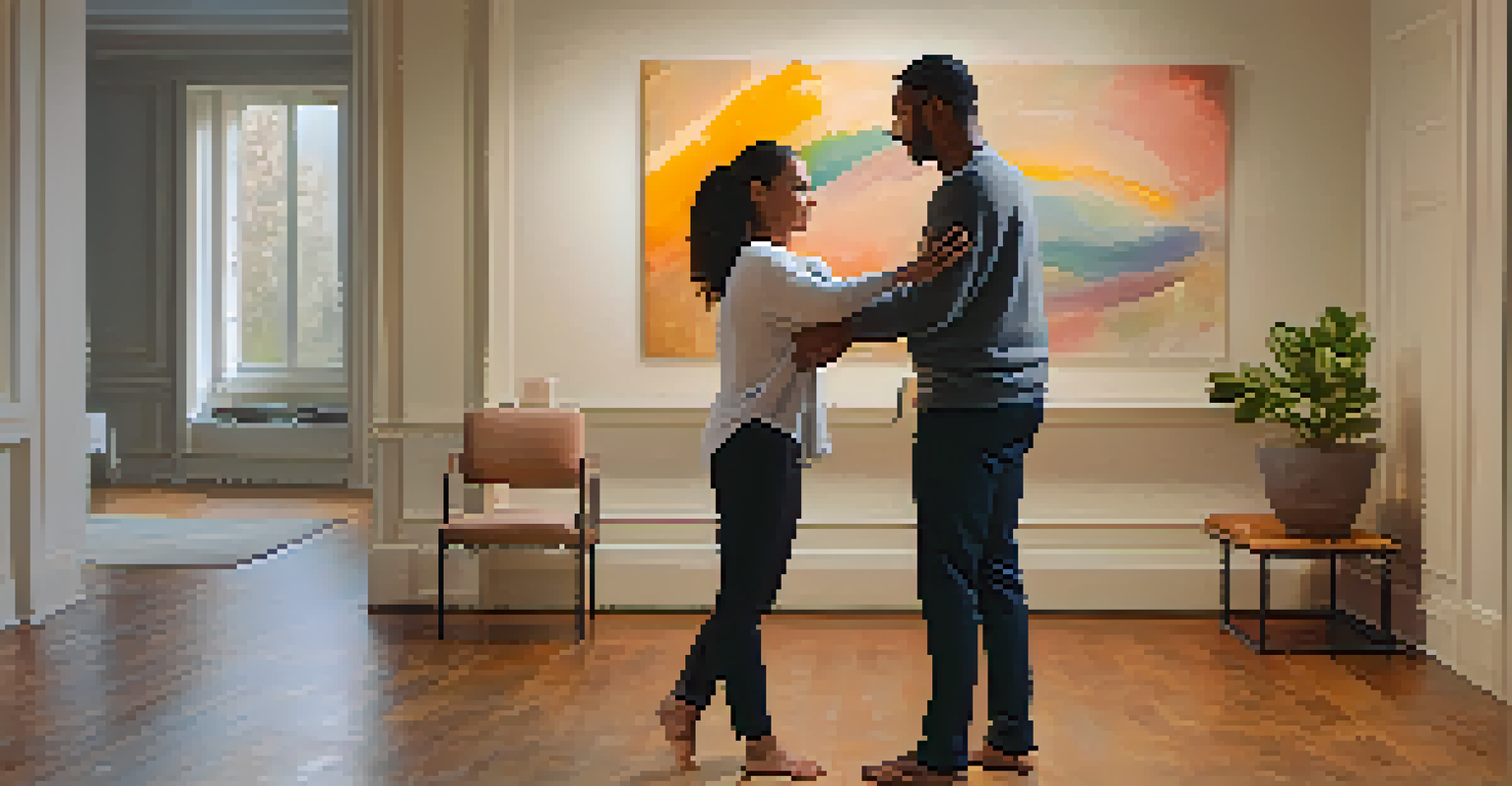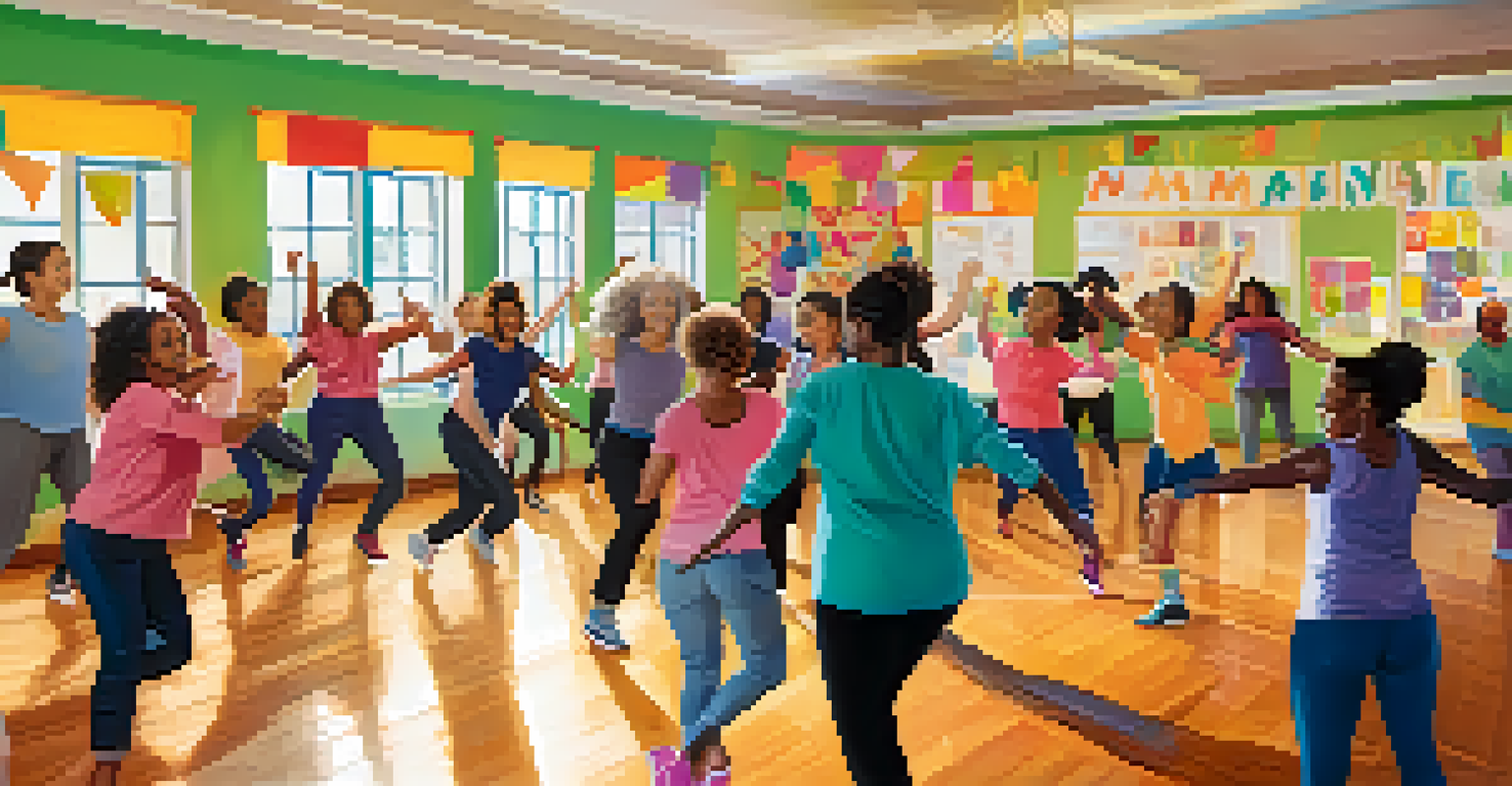Integrating Dance Therapy into Traditional Mental Health Care

Understanding Dance Therapy and Its Benefits
Dance therapy, also known as dance/movement therapy, combines the expressive art of dance with psychological principles. It encourages individuals to express their emotions through movement, promoting healing and self-discovery. This therapeutic approach can be especially beneficial for those who find it challenging to articulate their feelings verbally.
Dance is the hidden language of the soul.
By engaging in dance, participants can release pent-up emotions and improve their mental well-being. Studies have shown that dance therapy can reduce symptoms of anxiety, depression, and trauma, making it a valuable addition to traditional mental health care. It fosters a sense of community, as participants often share their experiences with others in a supportive environment.
Moreover, dance therapy is adaptable, making it suitable for various age groups and abilities. Whether in a one-on-one setting or group sessions, it allows individuals to connect with their bodies and emotions, leading to greater self-awareness. This holistic approach complements conventional therapy methods by addressing both the mind and body.
The Science Behind Dance Therapy
Research into dance therapy reveals its profound impact on mental health. Studies indicate that movement can stimulate the release of endorphins, the body’s natural mood lifters. This biological response can lead to improvements in mood and a reduction in stress levels, making dance therapy a powerful tool in mental health care.

Furthermore, dance therapy has been shown to enhance cognitive function and improve social skills. Participants often engage in group activities that require cooperation and communication, fostering connections that are crucial for mental health. This aspect of dance therapy can be particularly helpful for individuals dealing with social anxiety or isolation.
Dance Therapy Enhances Mental Health
Dance therapy promotes emotional expression and can significantly reduce symptoms of anxiety, depression, and trauma.
It's also worth noting that dance therapy operates on the premise of mind-body connection, a concept supported by various psychological theories. By integrating physical movement with emotional expression, individuals can confront and process their feelings in a safe environment, ultimately leading to healing and personal growth.
Integrating Dance Therapy into Traditional Practices
To effectively integrate dance therapy into traditional mental health care, practitioners must collaborate closely. This collaboration can involve therapists, counselors, and dance movement specialists working together to design comprehensive treatment plans. This multi-disciplinary approach ensures that clients receive the most holistic care possible.
Movement is a medicine for creating change in a person's physical, emotional, and mental states.
Additionally, training mental health professionals in the fundamentals of dance therapy can enhance their therapeutic toolbox. By understanding how movement influences emotional expression, these professionals can create more inclusive environments for their clients. This integration can lead to more personalized treatment experiences that cater to individual needs.
Incorporating dance therapy within existing programs can also attract a broader range of clients. Some individuals may be more inclined to engage in a therapeutic practice that emphasizes movement and creativity over traditional talk therapy. This flexibility can make mental health care more accessible and appealing to those who may feel hesitant about conventional approaches.
Real-Life Success Stories
Across the globe, many individuals have found success in integrating dance therapy into their mental health journeys. One notable example is a community center that introduced dance therapy sessions for at-risk youth. Participants reported feeling more confident and connected after experiencing the joy of movement together, showcasing the power of dance as a healing tool.
Another inspiring story involves a woman who battled depression for years. After joining a dance therapy group, she discovered a new sense of freedom in expressing herself through movement. This newfound outlet not only improved her mood but also helped her build relationships with others, illustrating how dance can foster both individual growth and community support.
Integration with Traditional Care
Combining dance therapy with conventional mental health practices offers a more holistic approach, catering to diverse client needs.
These stories highlight the transformative potential of dance therapy. They serve as reminders that healing can take many forms and that combining traditional methods with creative approaches can yield remarkable results.
Challenges in Implementing Dance Therapy
Despite its benefits, integrating dance therapy into traditional mental health care is not without challenges. One significant hurdle is the lack of awareness and understanding among mental health professionals regarding dance therapy. Some may not see it as a valid therapeutic approach, which can hinder its implementation.
Additionally, logistical issues, such as finding suitable spaces for movement-based therapy, can pose obstacles. Traditional therapy settings may not always accommodate the physical aspects of dance, limiting the opportunity for full engagement. Addressing these practical concerns is essential for successful integration.
Lastly, funding for dance therapy programs can be an issue, especially in resource-limited settings. Advocating for the value of dance therapy and securing support from mental health organizations can help overcome these challenges, ensuring that this innovative approach reaches those who need it.
The Role of Training and Certification
To ensure effective integration of dance therapy into mental health care, proper training and certification are crucial. Dance/movement therapists undergo rigorous education that covers both psychological principles and the art of dance. This training equips them to address a wide range of mental health issues through movement.
Certification also helps establish credibility within the mental health community. When mental health professionals understand the qualifications and expertise of dance therapists, they are more likely to refer clients to them. This relationship is vital for creating a supportive network that values diverse therapeutic approaches.
Success Stories Showcase Impact
Real-life examples illustrate how dance therapy can transform lives by fostering community and personal growth.
Moreover, ongoing education and workshops can keep practitioners updated on the latest research and methods in dance therapy. This commitment to professional development ensures that clients receive the highest standard of care, blending traditional and innovative practices seamlessly.
Looking Ahead: Future of Dance Therapy
As awareness of mental health issues continues to grow, so does the potential for dance therapy’s integration into traditional practices. The ongoing dialogue about holistic treatment methods encourages mental health professionals to explore diverse therapies. This shift in perspective opens the door for more individuals to benefit from creative healing practices.
Furthermore, advancements in technology can also play a significant role in the future of dance therapy. Virtual classes and online resources can make dance therapy more accessible, allowing individuals to participate from the comfort of their homes. This adaptability could reach underserved communities and promote mental health awareness on a broader scale.

Ultimately, the future of dance therapy looks promising as it carves out a space within the mental health landscape. With continued research, collaboration, and advocacy, dance therapy can become an essential component of comprehensive mental health care, enriching the lives of many.